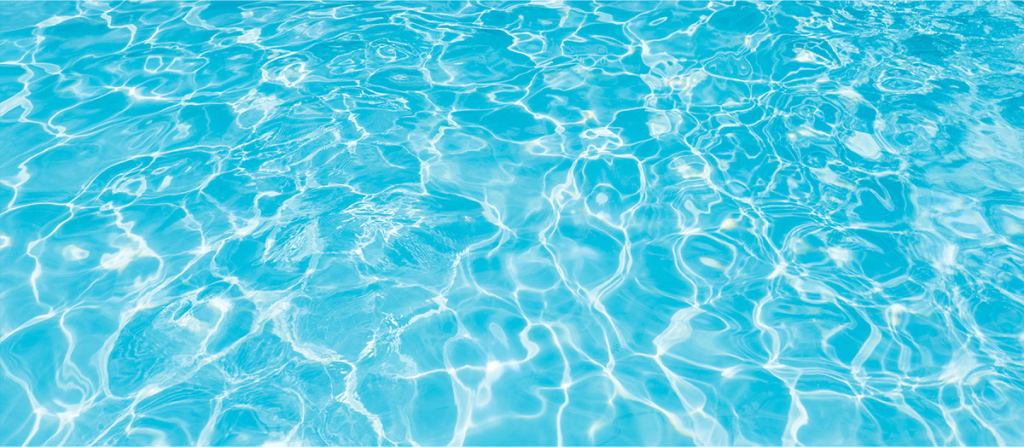Are you tired of the endless struggle with cloudy water? In this case, the pool flocculant will come to the rescue. However, you should be aware that this chemical won’t help in 100% of cases, as there are many reasons why water becomes cloudy. Moreover, sometimes pool owners confuse flocculants with clarifiers, which have a completely different principle of water treatment.
Therefore, to be 100% aware, we have gathered a detailed guide about pool flocculants. Explore it to understand whether you should use it, how fast it copes with a task, which flocs are the best, and how they differ from pool clarifiers.
Best Pool Flocculants Comparison Table
| Name | Characteristics | What makes it the best? |
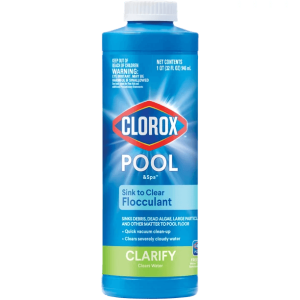 Clorox Pool&Spa Flocculant Winning category The most effective water cleaning | Amazon rating: 4.6 Item volume: 1 qt. (32 fl. oz.) Consumption: ¼ qt (8 fl. oz.) per 10,000 gallons Form: liquid Using duration: 12–24 hours | The most effective water cleaning – almost 100% of users state that it clears cloudy water The clearest instructions – 40% of users state that you’ll definitely achieve a result when following the instructions More than 20% of users state that it allows to “open” a pool before the swimming season Detailed review |
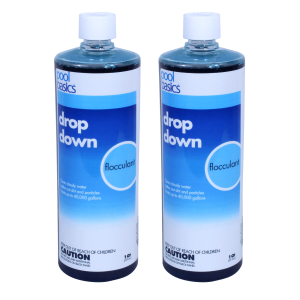 Pool Basics Liquid Flocculant Winning category The most effective debris gathering | Amazon rating: 4.5 Item volume: 1 qt. (32 fl. oz.) Consumption: ¼ qt (8 fl. oz.) per 10,000 gallons Form: liquid Using duration: 24–72 hours | The most effective debris gathering – more than 80% of users state that it gathers all the debris The easiest to use – add a flocculant, brush walls, wait for a while, and check the result Safe for other chemicals levels Detailed review |
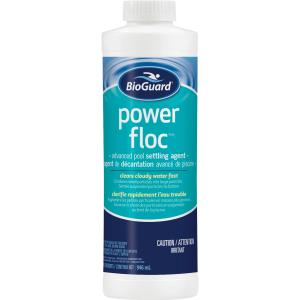 BioGuard Powerfloc Winning category The fastest water cleaning | Amazon rating: 4.5 Item volume: 1 qt. (32 fl. oz.) Consumption: ¼ qt (8 fl. oz.) per 10,000 gallons Form: liquid Using duration: 12–24 hours | The fastest water cleaning – treats water from three to six times faster than other flocs The most economical – more than 40% of users state that one dose treats the whole pool 80% of users admit its efficiency Detailed review |
What Is a Pool Flocculant

A pool flocculant is a chemical pool cleaner that purifies cloudy water. Its working principle is based on flocculation. It is a process during which small particles like dirt, oils, and other contaminants that cannot be caught by the filter are collected into large ones and settled on the bottom.
When to Use It
The pool flocculant is one of the few chemicals you can use infrequently. You should add it only when the pool water is cloudy or murky, and ordinary chemicals or filtration do not help to eliminate it.
Also, the users we interviewed indicated that the flocculant works for opening the pool and gathering dead algae.
— Mary Johnson-DeLeon, GA
How to Use It
Each of the best pool flocculants has detailed instructions on how to use them on the label. However, a general algorithm can be distinguished, which we have indicated below.
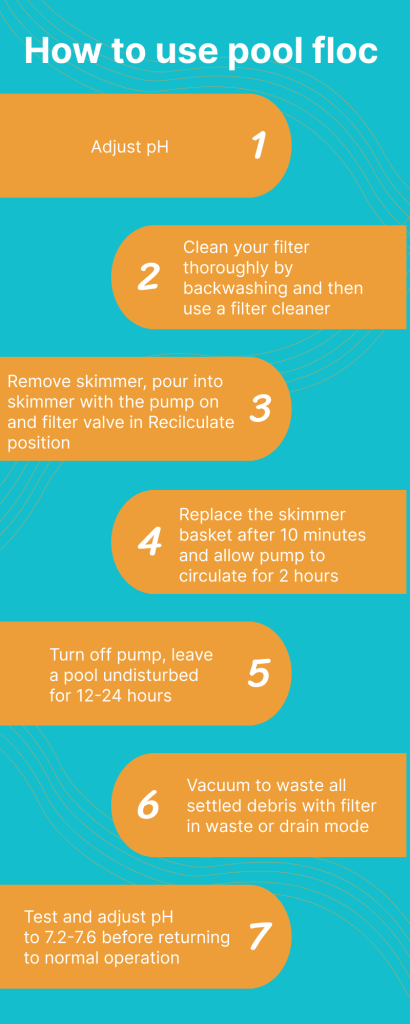
Moreover, you should strictly follow the manufacturer’s instructions to avoid excessive accumulation of settled on the bottom particles, as they can clog the filter.
How Much Time Does It Take to Clear Water
Based on the amount of time described in the general algorithm, you should wait from 26 to 50 hours for the water to become clear. However, some users noted that their flocs cleared water overnight:
“I woke up the next day, and the top 95% of the water was crystal-clear.“
— Software/electrical engineer, MI
Also, if your chemical levels are imbalanced or there are high levels of dissolved solids, you may need more than one treatment because they cause water to be cloudy.
3 Best Pool Flocculants To Make Your Water Crystal Clear
We’ve understood what pool flocs are, how they work, how to use them, and how fast they clean water. Therefore, it’s time to get acquainted with the best flocculants. Explore their detailed reviews to select one that matches your requirements the best.
Clorox Pool&Spa Flocculant – The Most Effective Water Cleaning

The most effective water cleaning
Clorox Pool&Spa Flocculant is the most effective in water treatment. It’s a crucial indicator for pool flocculant because it is designed to make your pool water sparkling clear. Almost 100% of users note its high efficiency, which is up to 20% better than other flocculants.
“Unsurprisingly, not many people use this effective pool floc. After applying it, all the small particles gather and settle at the pool’s bottom, making it effortless to vacuum them up and achieve a sparkling clearness.“
— William, Walmart user
Moreover, users note that using this flock, they opened the pool after the winter. It is a unique feature because less than <30% of flocculants have it.
“After winter, when we decided to reopen our 18-inch pool, we encountered a significant accumulation of unsightly algae. To address this issue, I decided to pour the entire bottle into our pool. Remarkably, after 24 hours, the water at the surface became crystal clear, while the algae sank to the bottom.“
— Martin N., Walmart user
Another advantage of the Clorox Pool&Spa Flocculant is the clearest instructions. More than 40% of users mention it, which is 20% more often than users of other flocculants.
“Before usage, it is essential to shake the product thoroughly. Additionally, you should set your filter to “RECIRCULATE” mode and pour the flocculant into the skimmer. Regrettably, numerous individuals appear to be in a rush and neglect to read or adhere to the provided instructions. Consequently, any negative outcomes can be attributed to their actions rather than the product itself.“
— Chris J., Walmart user
Pros
- The most effective in making water sparkling clear – up to 100% of users admit its effectiveness, which is up to 40% more than other flocs have
- Users’ choice #1 – has the highest Amazon rating of 4.6 stars
- Safe for pool finishes – according to user reviews, it will not spoil even vinyl, painted, or metallic pools
Cons
- It may be a reason for skin irritation, so you should wash your hands immediately after using
Pool Basics Liquid Flocculant – The Most Effective Debris Gathering
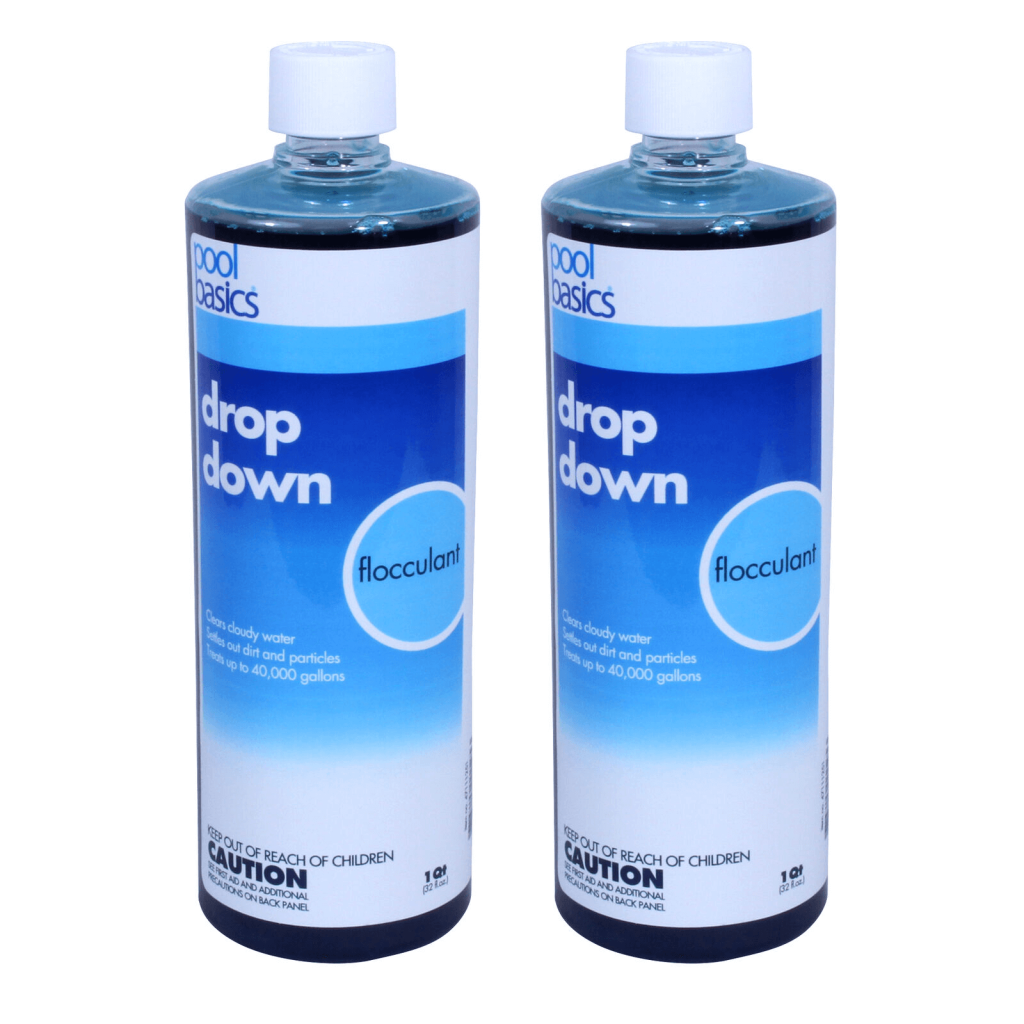
The most effective debris gathering
Pool Basics Liquid Flocculant provides the most efficient debris gathering. It’s also one of the crucial factors, as debris gathering is how pool flocs work. Therefore, you can be sure that after vacuuming, it will become crystal clear.
“I used it following the directions, and the next morning, the water was sparkling clear because all the algae were at the bottom, so they could be vacuumed.“
— D. Honstetter, NY
The second advantage of this flocculant is its ease of use in challenging situations. For example, if the walls and steps of your pool are covered in algae, you should turn off the pump, add 4 ounces per 5,000 gallons, and brush the walls. After 24–72 hours, all debris will settle on the floor, so you can vacuum it up.
“I put 4 oz in a 5,000 gal pool, and within 48 hours, everything making the pool cloudy sat nicely on the bottom to be cleaned out by the vacuum.”
— MM, Amazon user
Finally, Pool Basics Liquid Flocculant is safe to use, as it doesn’t adversely affect other chemical levels. It’s important because you don’t want to spend extra money on other chemicals.
“After adding it, chemical levels were balanced wisely.“
— Von, MD
Pros
- The most effective debris gathering – 80% of users admit its efficiency, which is up to 20% more than other flocs
- The easiest to use – up to 30% of users admit its straightforward use, which is up to 20% more than other flocs
- High efficiency – up to 90% of users admit that this floc helped them
Cons
- This floc has the lowest cleaning rate, which is up to 3 times slower than other chemicals
BioGuard Powerfloc – The Fastest Water Cleaning
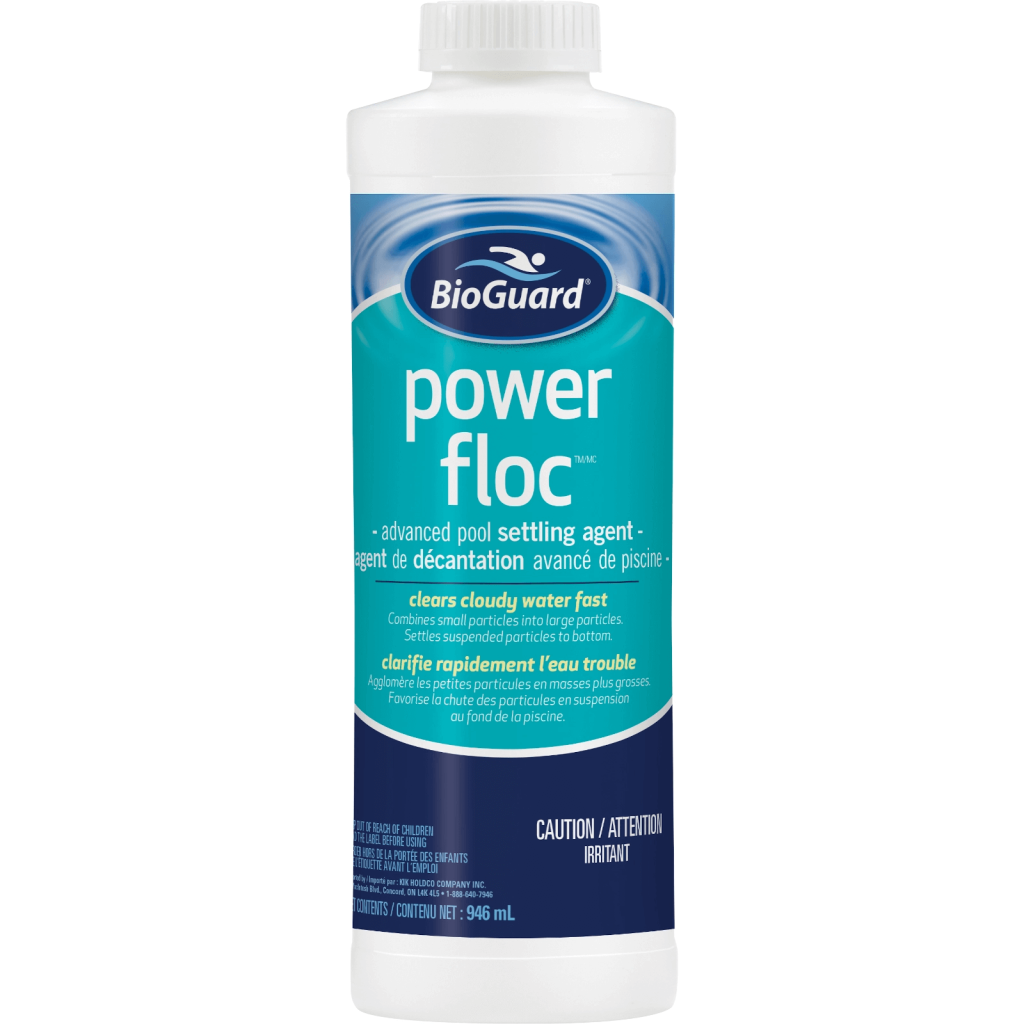
The fastest water cleaning
BioGuard Powerfloc is a flocculant that has the highest cleaning rate. This indicator can be crucial if you want to get rid of cloudiness in the shortest possible time. This flocculant allows you to do this in 12–24 hours, which is up to six times faster than other chemicals. Moreover, it has a high-efficiency rate, as about 80% of users report it.
“I applied it at night, and the next day, the top 95% of the water was crystal-clear with all debris lying on the bottom.”
— Software/electrical engineer, MI
Another feature is its economy. More than 40% of users say that one dose (8 oz. per 10,000 gallons) was enough for them. By comparison, other flocs may require up to twice as much chemical to achieve the desired result.
“My pool was clean in 12 hours right after the first application of this product.“
— Mary D Morrill, LA
However, keep in mind that the pool will only be clean after you vacuum it. However, you won’t get any vacuum that exhausts water into the pool (e.g., a battery-powered one or a filter vac without a ‘waste’ mode) because they won’t gather all the debris.
Pros
- The fastest water cleaning – make your water sparkling clear in 12–24 hours, while other flocs can do it in 24–72 hours
- The most economical – one dose of this floc can treat 10,000 gallons, which is up to two times less than other chemicals
- Safe for cartridge and sand filters
Cons
- Has lower efficiency than the other two flocs, but this indicator is still very high (app. 80% of users admit its efficiency)
Is Pool Flocculant Safe For Your Water And Equipment

Generally, if you use the flocculant as directed, your pool and equipment should be OK. However, there are three points you should pay attention to that will make your pool and equipment 100% safe.
- Monitor pH and total alkalinity. Some pool flocculants may affect pH and TA levels, so you should check and adjust them before and after the treatment.
- Monitor filter. Some pool flocs can clog filters, especially when they are old or defective. In this case, you need to monitor the pressure in the filtration system while using the flock and backwash/clean filter. Keep in mind that pool flocculants work well with sand and filters.
- Store in the right place. To prevent your flock from spoiling and harming you, you should store it in a dry, cool, and well-ventilated place.
Pool Flocculant vs. Pool Clarifier
Clarifiers and flocculants have the same purpose – to make water crystal clear. However, the principle of work, the required time, and the dosage differ. In the table below, we’ve provided a detailed comparison so that you know exactly in which case you need a clarifier and in which one you need flocculant.
| Item |  Pool flocculant | 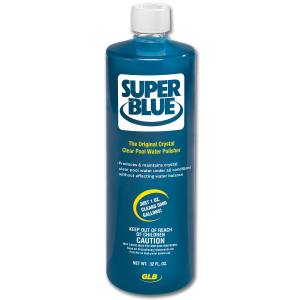 Pool clarifier |
| Active ingredient | Aluminum sulfate | Sodium sulfate and polyaluminum chloride |
| Cleaning rate | 12–72 hours | 12–24 hours |
| Consumption per 10,000 gallons | app. 8 oz. | app. 2 oz. |
| Frequency of use | Irregular, when the water is very turbid or contains fine suspended particles that are difficult to remove with a conventional filter. | Irregular, when the water has undesirable tints or stains, or you want to reach a more attractive pool appearance |
| Principle | Forms flocks, or clumps, of tiny particles, making them easier to remove by filtering or settling on the pool bottom. | Contains oxidizing agents that interact with organic substances or metals, causing them to oxidize and lighten the color of the water. |
Summary
Pool flocculant is not a one-size-fits-all pool cleaner, as it serves one purpose – keeping the water crystal clear. This chemical forms flocks, depositing debris on the pool’s bottom, so you can vacuum them. However, not every flocculant can do this effectively.
Therefore, we read 500+ user reviews about the best pool flocculants according to Amazon estimates, and using , we chose the top three. Each is the best in a particular category and can easily clean your pool!
FAQ
🧐 What is a pool flocculant?
This is a chemical which forms flocs from debris, settling them to the bottom and allowing you to vacuum or filter them.
🏊♂️ Is it possible to swim in the pool after adding a pool flocculant?
You should avoid swimming in the pool right after adding a pool flocculant because it can cause skin and eye irritation.
☝️ Are pool flocculants compatible with sand and cartridge filters?
Yes. However, keep in mind to flush or backwash them regularly to prevent their breakage. For cartridge filters, flush them when the pressure gauge on the filter reaches 8 to 10 psi above the clean pressure. As for sand, flush them at least once a month.
❕ Which types of vacuum cleaners aren’t compatible with pool flocs?
Any vacuum that exhausts water into the pool isn’t compatible with pool flocs, as they don’t collect debris.


